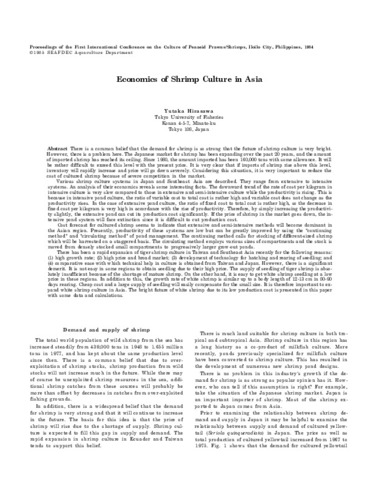Economics of shrimp culture in Asia
- Global styles
- MLA
- Vancouver
- Elsevier - Harvard
- APA
- Help
Share
Abstract
There is a common belief that the demand for shrimp is so strong that the future of shrimp culture is very bright. However, there is a problem here. The Japanese market for shrimp has been expanding over the past 20 years, and the amount of imported shrimp has reached its ceiling. Since 1980, the amount imported has been 160,000 tons with some allowance. It will be rather difficult to exceed this level with the present price. It is very clear that if imports of shrimp rise above this level, inventory will rapidly increase and price will go down severely. Considering this situation, it is very important to reduce the cost of cultured shrimp because of severe competition in the market.
Various shrimp culture systems in Japan and Southeast Asia are described. They range from extensive to intensive systems. An analysis of their economics reveals some interesting facts. The downward trend of the rate of cost per kilogram in intensive culture is very slow compared to those in extensive and semi-intensive culture while the productivity is rising. This is because in intensive pond culture, the ratio of variable cost to total cost is rather high and variable cost does not change as the productivity rises. In the case of extensive pond culture, the ratio of fixed cost to total cost is rather high, so the decrease in fixed cost per kilogram is very high in accordance with the rise of productivity. Therefore, by simply increasing the productivity slightly, the extensive pond can cut its production cost significantly. If the price of shrimp in the market goes down, the intensive pond system will face extinction since it is difficult to cut production cost.
Cost forecast for cultured shrimp seems to indicate that extensive and semi-intensive methods will become dominant in the Asian region. Presently, productivity of these systems are low but can be greatly improved by using the "continuing method" and "circulating method" of pond management. The continuing method calls for stocking of different-sized shrimp which will be harvested on a staggered basis. The circulating method employs various sizes of compartments and the stock is moved from densely stocked small compartments to progressively larger grow-out ponds.
There has been a rapid expansion of tiger shrimp culture in Taiwan and Southeast Asia recently for the following reasons: (1) high growth rate; (2) high price and broad market; (3) development of technology for hatching and rearing of seedling; and (4) comparative ease with which technical help in culture is obtained from Taiwan and Japan. However, there is a significant demerit. It is not easy in some regions to obtain seedling due to their high price. The supply of seedling of tiger shrimp is absolutely insufficient because of the shortage of mature shrimp. On the other hand, it is easy to get white shrimp seedling at a low price in these regions. In addition to this, the growth rate of white shrimp is similar up to a body length of 12-13 cm in 80-90 days rearing. Cheap cost and a large supply of seedling will easily compensate for the small size. It is therefore important to expand white shrimp culture in Asia. The bright future of white shrimp due to its low production cost is presented in this paper with some data and calculations.
Suggested Citation
Hirasawa, Y. (1985). Economics of shrimp culture in Asia. In Y. Taki, J. H. Primavera, & J. A. Llobrera (Eds.), Proceedings of the First International Conference on the Culture of Penaeid Prawns/Shrimps, 4-7 December 1984, Iloilo City, Philippines (pp. 131–150). Iloilo City, Philippines: Aquaculture Department, Southeast Asian Fisheries Development Center.
Type
Conference paperISBN
9718511008



